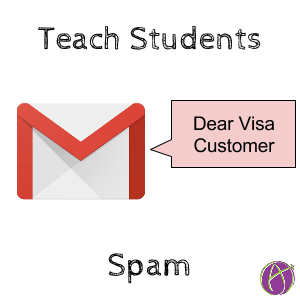

When possible, it is important that we educate our students on how to be safe on the web. Scammers are always out there trying to take your personal information and money. When you receive spam/scam email that does not have inappropriate information try asking students to determine if this is a valid email and why or why not. Students can practice critical thinking skills and gain valuable knowledge to keep themselves safe in the future.
- Check the email address.
- Is it from the expected company?
- Is it spelled correctly?
- Are there extra words along with the company name in the email address?
A spammer is unable to purchase visa.com but could purchase visasalesforce.com possibly.
- Never click on links!
- Hover over the link to see where the destination URL goes. Most likely it is not visa.com. Even if it looks like it is going to where you think it should go, do not click on the link.
- Go directly to the website yourself. Type in the web address for Visa, PayPal or whatever website you think is contacting you.
- Are images and logos present?
- Lack of images and logos is a surefire sign of spam.
- The presence of images and logos does not indicate that the email is valid. It is incredibly easy to download images off of the web or to modify a legitimate email and send it out.
- Be extra vigilant when the email looks legitimate.
- Does the email include your name and some account information that only the company would know?
- “Dear Visa Customer” screams scam. Visa knows your name.
- Visa will include the last 4 digits of your card number in an email.
Even then, scrutinize carefully the email.







